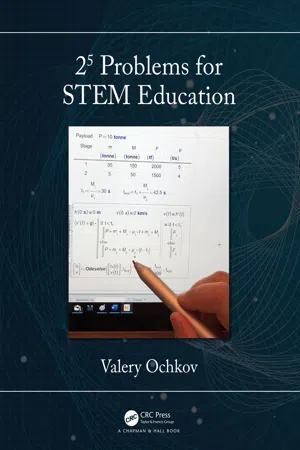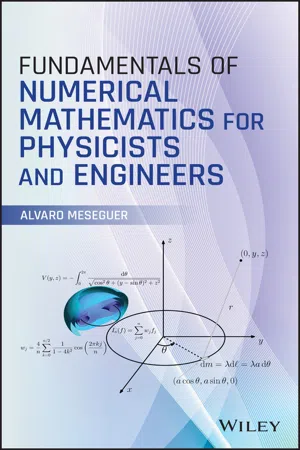Mathematics
Linear Interpolation
Linear interpolation is a method of estimating a value between two known values by drawing a straight line between them. It is commonly used in mathematics and other fields to estimate values that fall within a given range. The method is based on the assumption that the relationship between the two known values is linear.
Written by Perlego with AI-assistance
Related key terms
Related key terms
1 of 4
Related key terms
1 of 3
3 Key excerpts on "Linear Interpolation"
- eBook - ePub
- Valery Ochkov(Author)
- 2020(Publication Date)
- Chapman and Hall/CRC(Publisher)
* In these tables, pairs of “temperature-property” numbers are shown only for certain temperature values, for example, 0, 10, 20, 30, etc. degrees on the Celsius scale. And the value of the property (the thermal conductivity of the metal or the density of the solution) should, for example, be taken at 17°C. It is understood that the values indicated in the tables are accurate (to be more precise, they were obtained with a sufficient degree of accuracy). Since physical laws allow us to consider the analyzed quantities to be functionally dependent, interpolation is used. The simplest is the Linear Interpolation while the interpolation by polynomials or splines is more complex. With Linear Interpolation, we fix two points, mentally, on paper or on the computer display, draw a straight line through them and find the desired intermediate value on that line. In non-Linear Interpolation, a function having a certain smoothness is sought, the graph of which passes through the indicated points (interpolation knots).* Previously, we had to determine from the tables the value of trigonometric, logarithmic, exponential and other elementary functions. Now the tables of values of special functions, for example, the differential and integral Laplace functions, are actively used.However, we should always remember that in the absence of any specific functional relationship between the two quantities, interpolation can lead to a false result.Once, before a lecture on “Regression Analysis” on a course on “Information Technology”, the author selected the example of a statistical sample for such analysis. However, when he “climbed the pulpit” and looked at the audience (Figure 14.1 ), he realized that a sample was right in front of his eyes. A roll call of students was conducted. The young men got up and reported their weight * and height (female students were exempted from this procedure, for obvious reasons). The numbers were recorded in the two vectors with names Weight and Height in Mathcad. Fifty elements were obtained in the vectors. These arrays of numbers served as a good example for the lecture.* It was, of course, the mass of a student, not the weight.FIGURE 14.1 Students: “experimental statistical rabbits” (author’s photo).As already noted, there are two main methods for the initial processing of the obtained data: approximation (by conducting a line near the points) and interpolation (by setting a line through the selected points). Each method will provide some insight into the dependence (functional or statistical) of the two quantities. Each method has strengths and weaknesses, and also its own features for the computer implementation.Let’s start with interpolation. It (theoretically) can be implemented with the help of any known function, but in practice it is usually done by polynomials. And first of all, polynomials of the first degree, whose graphs are straight lines on the plane. This interpolation is called linear. - eBook - ePub
- G. M. Phillips, Peter J. Taylor(Authors)
- 1996(Publication Date)
- Academic Press(Publisher)
f is one which we naturally ask; we pursue this later using a technique similar to that employed in examining the error of the Taylor polynomial.Some insight into Linear Interpolation can be gained by studying tables of standard mathematical functions. Such tables were an indispensable part of the toolkit of the numerical analyst from, say, the seventeenth century to the later part of the twentieth century, when the universal availability of adequate computing power made them obsolete. In these mathematical tables, functions are usually tabulated at equal intervals. A mathematician who constructed such a table had to answer two questions: to how many decimal places and at what interval (between consecutive entries in the table) should the function be evaluated? In practice these questions turned out to be related. The constructor of a mathematical table first decided on the number of decimal places to which the function would be evaluated at the tabulated points. The interval size was then chosen so that Linear Interpolation between consecutive entries would roughly preserve this level of accuracy. (It is easy to think of this graphically: choose an interval small enough so that the graph of the function is sufficiently close to the graph of a straight line.) As an example, for the function sin x we find that an interval of 0.01 radians is used in the four-figure table, while an interval of 0.001 is used in the six-figure table.Example 4.1
From a set of four-figure tables of natural logarithms, we find that log 2.1 is 0.7419 and log 2.2 is 0.7885. We use Linear Interpolation on these two values to estimate log 2.14. Here it is simplest to calculate p x (x) from (4.3) , with x 0 = 2.1, x 1 = 2.2, f(x 0 ) = 0.7419, f(x 1 ) = 0.7885 and x - Alvaro Meseguer(Author)
- 2020(Publication Date)
- Wiley(Publisher)
As we will see in Chapters 3 and 4, polynomial interpolation lies at the very heart of the most commonly used rules to approximate derivatives and integrals (quadratures) of functions. In Part II, we will also address how to apply polynomial interpolation to approximate the solution of ordinary differential equations in its two possible frameworks: initial and boundary value problems. 2.2 Polynomial Interpolation We are all familiar with the fundamental algebraic problem of determining the expression of the straight line that passes through two given points and. To obtain the coefficients and, we simply impose the conditions and that lead to the linear system of equations (2.1) Assuming that, we can solve system (2.1) and provide the requested coefficients and so that the sought straight line is (2.2) Since the solution above is a polynomial of degree 1, a natural question is whether this procedure can be applied to find polynomials of suitable degree passing through an arbitrary number of points. The answer is yes, and the mathematical technique that provides such polynomials is called polynomial interpolation. Suppose we are given a set of distinct abscissas and arbitrary ordinates. Imagine that we want to find a polynomial of degree that passes through the points, as shown in the figure below. Let this polynomial be (2.3) with being unknown coefficients. As we did for the case of the straight line, we can identify the coefficients by imposing (2.4) that is, the polynomial must pass through the given points. The reader may easily check that equations (2.4) lead to a linear system for the undetermined coefficients whose matrix form is (2.5) The square matrix with elements appearing on the left‐hand side of (2.5) is usually referred to as the Vandermonde's matrix 1 associated with the abscissas, and whose determinant is (see Problem 2.1) (2.6) Since the abscissas are assumed to be different,. Consequently, system (2.5) has always a unique solution
Index pages curate the most relevant extracts from our library of academic textbooks. They’ve been created using an in-house natural language model (NLM), each adding context and meaning to key research topics.
Explore more topic indexes
Explore more topic indexes
1 of 6
Explore more topic indexes
1 of 4


